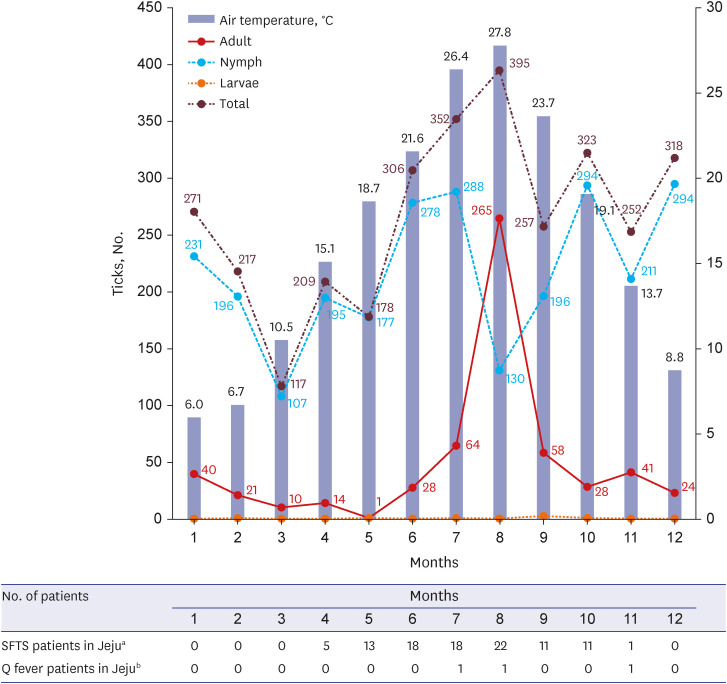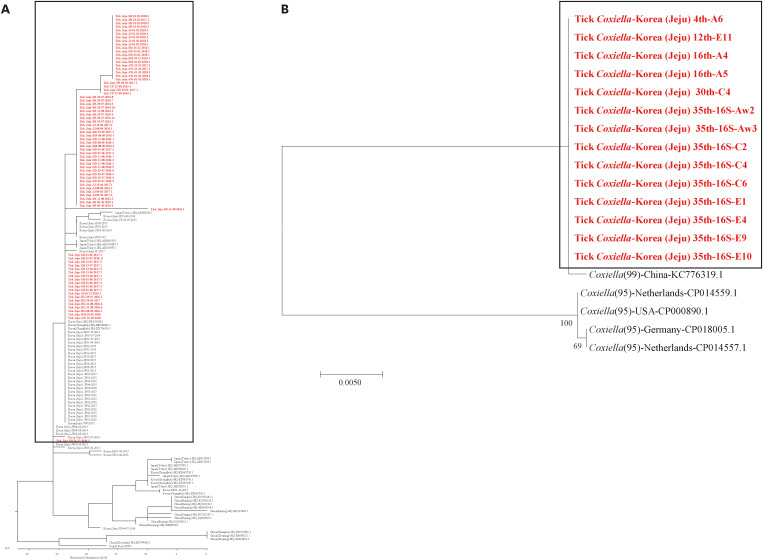J Korean Med Sci.
2023 May;38(20):e156. 10.3346/jkms.2023.38.e156.
Coinfection of Severe Fever With Thrombocytopenia Syndrome Virus and Coxiella burnetii in Developmental Stage of Hard Ticks in Subtropical Region of Korea
- Affiliations
-
- 1Department of Internal Medicine, Jeju National University, College of Medicine, Jeju, Korea
- 2Department of Internal Medicine, Jeju National University Hospital, Jeju, Korea
- 3Department of Microbiology and Immunology, Jeju National University, College of Medicine, Jeju, Korea
- 4Department of Microbiology, Hanyang University College of Medicine, Seoul, Korea
- KMID: 2542595
- DOI: http://doi.org/10.3346/jkms.2023.38.e156
Abstract
- Background
Severe fever with thrombocytopenia syndrome virus (SFTSV) is transmitted through tick bites. Ticks are potential vectors for the bacterium Coxiella burnetii that causes Query fever. Here, we analyzed SFTSV and C. burnetii co-infection rates in ticks in rural areas of Jeju Island, South Korea.
Methods
Free ticks were collected from the natural environment of the island between 2016 and 2019, and SFTSV RNA was extracted. Additionally, ribosomal RNA gene sequencing was used to identify Coxiella species.
Results
Haemaphysalis longicornis was the most common tick species followed by H. flava. Tick number gradually increased from April, peaked in August, and was lowest in March. Of all the collected ticks, 82.6% (2,851/3,458) were nymphs, 17.9% (639/3,458) adults, and 0.1% (4/3,458) larvae. SFTSV-infected ticks comprised 12.6% of all ticks; their numbers were the lowest in November–December, increased from January, and were mostly identified in the adult stage during June–August. C. burnetii infections were detected in 4.4% of the SFTSVinfected H. longicornis ticks. C. burnetii co-infection was mainly observed in the nymph stage of H. longicornis, with the highest infection rate in January, followed by December and November.
Conclusion
Our findings suggest that Jeju Island has a high SFTSV and potential C. burnetii infection in ticks. This study provides important insights regarding SFTS and Q fever risk to humans in South Korea.
Keyword
Figure
Reference
-
1. Dehhaghi M, Kazemi Shariat Panahi H, Holmes EC, Hudson BJ, Schloeffel R, Guillemin GJ. Human tick-borne diseases in Australia. Front Cell Infect Microbiol. 2019; 9:3. PMID: 30746341.2. Madison-Antenucci S, Kramer LD, Gebhardt LL, Kauffman E. Emerging tick-borne diseases. Clin Microbiol Rev. 2020; 33(2):e00083-18. PMID: 31896541.3. Perveen N, Muzaffar SB, Al-Deeb MA. Ticks and tick-borne diseases of livestock in the middle East and North Africa: a review. Insects. 2021; 12(1):83. PMID: 33477991.4. Song B, Lee W, Ju Y. Geographical distribution of Ixodid ticks in the Republic of Korea, 2015. Public Health Wkly Rep. 2017; 10(10):239–245.5. Seo JW, Han SY, Sung SH, Jung EY, Kim JH, Lee SJ, et al. Survey on tick distribution and tick-borne pathogens in Daejeon and adjacent areas in South Korea. Ticks Tick Borne Dis. 2021; 12(4):101711. PMID: 33774480.6. Heo ST, Yoo JR, Lee KH, Ko KS. The first case of non-retrospective clinical identification of severe fever with thrombocytopenia syndrome patient in 2013 in South Korea. J Bacteriol Virol. 2015; 45(2):155–158.7. Kim KH, Yi J, Kim G, Choi SJ, Jun KI, Kim NH, et al. Severe fever with thrombocytopenia syndrome, South Korea, 2012. Emerg Infect Dis. 2013; 19(11):1892–1894. PMID: 24206586.8. Yu XJ, Liang MF, Zhang SY, Liu Y, Li JD, Sun YL, et al. Fever with thrombocytopenia associated with a novel bunyavirus in China. N Engl J Med. 2011; 364(16):1523–1532. PMID: 21410387.9. Korea Disease Control and Prevention Agency (KDCA). Statistical System of Notifiable Disease Surveillance System (2013–2021). Updated 2023. Accessed April 10, 2022. https://is.cdc.go.kr .10. Eldin C, Mélenotte C, Mediannikov O, Ghigo E, Million M, Edouard S, et al. From Q fever to Coxiella burnetii infection: a paradigm change. Clin Microbiol Rev. 2017; 30(1):115–190. PMID: 27856520.11. Yoo JR, Kim MS, Heo ST, Oh HJ, Oh JH, Ko SY, et al. Seroreactivity to Coxiella burnetii in an agricultural population and prevalence of Coxiella burnetii Iinfection in ticks of a non-endemic region for Q fever in South Korea. Pathogens. 2021; 10(10):1337. PMID: 34684286.12. Kim JH, Choi YJ, Lee KS, Kim JE, Oh JW, Moon JH. Severe fever with thrombocytopenia syndrome with Q fever coinfection in an 8-year-old girl. Pediatr Infect Dis J. 2021; 40(1):e31–e34. PMID: 33105338.13. Korea Meteorological Administration (KMA). Jeju’s Climatic Region. Updated 2023. Accessed December 17, 2022. http://www.kma.go.kr/eng/index.jsp .14. Tamura K, Stecher G, Peterson D, Filipski A, Kumar S. MEGA6: molecular evolutionary genetics analysis version 6.0. Mol Biol Evol. 2013; 30(12):2725–2729. PMID: 24132122.15. Yoo JR, Heo ST, Song SW, Bae SG, Lee S, Choi S, et al. Severe fever with thrombocytopenia syndrome virus in ticks and SFTS incidence in humans, South Korea. Emerg Infect Dis. 2020; 26(9):2292–2294. PMID: 32818414.16. Chae J. Survey of Severe Fever With Thrombocytopenia Syndrome Virus in Natural Environment and Study on Useful Meterial for Development of Tick Repellent. Incheon, Korea: National Institute of Environmental Research;2017. p. 1–329.17. Kang JG, Cho YK, Jo YS, Han SW, Chae JB, Park JE, et al. Severe fever with thrombocytopenia syndrome virus in ticks in the Republic of Korea. Korean J Parasitol. 2022; 60(1):65–71. PMID: 35247957.18. Liu Q, He B, Huang SY, Wei F, Zhu XQ. Severe fever with thrombocytopenia syndrome, an emerging tick-borne zoonosis. Lancet Infect Dis. 2014; 14(8):763–772. PMID: 24837566.19. White SA, Bevins SN, Ruder MG, Shaw D, Vigil SL, Randall A, et al. Surveys for ticks on wildlife hosts and in the environment at Asian longhorned tick (Haemaphysalis longicornis)-positive sites in Virginia and New Jersey, 2018. Transbound Emerg Dis. 2021; 68(2):605–614. PMID: 32639639.20. Oh H, Yoo JR, Kim M, Heo ST. Current status and infection control of severe fever with thrombocytopenia syndrome in Korea. Korean J Healthc Assoc Infect Control Prev. 2022; 27(1):18–27.21. Lee JH, Park HS, Jang WJ, Koh SE, Park TK, Kang SS, et al. Identification of the Coxiella sp. detected from Haemaphysalis longicornis ticks in Korea. Microbiol Immunol. 2004; 48(2):125–130. PMID: 14978338.22. Seo MG, Lee SH, Ouh IO, Lee GH, Goo YK, Kim S, et al. Molecular detection and genotyping of Coxiella-like endosymbionts in ticks that infest horses in South Korea. PLoS One. 2016; 11(10):e0165784. PMID: 27792764.23. Duron O, Sidi-Boumedine K, Rousset E, Moutailler S, Jourdain E. The importance of ticks in Q fever transmission: What has (and has not) been demonstrated? Trends Parasitol. 2015; 31(11):536–552. PMID: 26458781.24. Korea Disease Control and Prevention Agency (KDCA). Guideline for control of tick and rodent-borne infectious disease. Updated 2021. Accessed March 21, 2022. https://is.cdc.go.kr .
- Full Text Links
- Actions
-
Cited
- CITED
-
- Close
- Share
- Similar articles
-
- No Detection of Severe Fever with Thrombocytopenia Syndrome Virus from Ixodid Ticks Collected in Seoul
- The Association of Kawasaki Disease and Coxiella burnetii
- Distribution and Detection of Severe Fever with Thrombocytopenia Syndrome Virus in Ticks Collected from Jeollanam-do, Korea
- Prevalence of antibodies to the phase I antigen of coxiella burnetii , the Q fever agent, among residents in Korea
- Clinical and Genetic Features of Coxiella burnetii in a Patient with an Acute Febrile Illness in Korea




